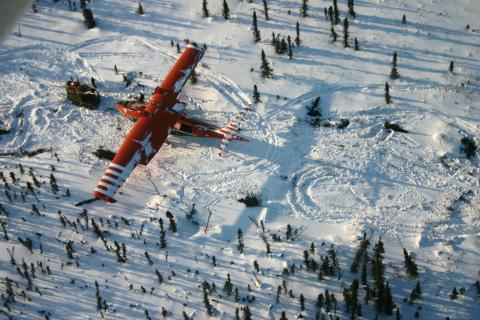Planning to be sucessful..... Edmonton Journal/Calgary Herald
by Doug Roy on 04/27/10
SALVAGING HISTORY
High arctic rescue mission launched for Canadian war plane
By Keith Gerein, Calgary Herald
And Wieben knew it all had to be done within a short window of time in early spring -- a part of the year when there was still snow on the ground, but temperatures were mild enough to work in.
Slowly, with the help of some friends and neighbours, an assignment that at first seemed impossible began to move closer to reality.
First to sign up were Joe Gans and Brian Wilson, who set to work welding together a pair of long skis that would fit around the Canso's wheels. Norbert Luken then joined in, along with Henry Dechant and Doug Roy, who used aerial photos to sketch out a route through the tundra.
The skis would allow the plane to slide across the snow, but the group also needed a machine strong enough to pull the plane, yet light enough to avoid damaging the tundra.
For help, Wieben visited a local seismograph services firm, which had a light track machine called a Yanmar. The firm's owner, after hearing Wieben's story about the mission, agreed to loan the vehicle at no charge. It was to be the first of several occasions the group received charity from people they barely knew.
Finally, during the first week of April 2008, Wieben, Gans, Luken and Wilson set out for Inuvik in a pair of one-tonne trucks and trailers carrying all the equipment.
Arriving in the Arctic town 48 hours later, the group used snowmobiles, the Yanmar and the help of a local guide, Albert Frost, to trek out to the plane.
Over the next five or six days, the men camped in Frost's tent beside the aircraft, working in limited daylight and -35 C cold to prepare the Canso for its journey.
Once the skis were securely attached, the first part of the moving operation called for the Yanmar to pull the plane across the frozen lake to the south shore.
The machine worked, barely, but progress was agonizingly slow. Carrying such a load, the Yanmar could travel six kilometres per hour. The group had to leave the plane on the lake overnight and come back the next day to finish the trip.
Even more difficult was the next leg of the journey -- traversing 30 kilometres of tundra to the Dempster Highway.
No longer on the smooth surface of the lake, the Yanmar struggled in the deep snow. To get anywhere, the men were forced to go ahead with their snowmobiles and pack down the trail.
"After two days, we were only halfway across the tundra," Wieben recalls. "It was taking us a lot longer than we expected and we were in a bit of a race. There was a forecast of warm weather coming and we knew we had to be off the tundra before the snow melted."
By that time, Dechant and Roy had flown to Inuvik to help. In town, they contacted a local business owner who agreed to send out a driver with a snow-cat, a bigger and more powerful machine than the Yanmar. Such service could have cost up to $10,000, but the owner refused to charge Wieben's crew anything, agreeing instead to take a free ride on the plane if it ever became airworthy.
At 11 p.m. the next day, the plane made it to the highway.
"That was a great moment," Roy says. "It was a celebration to have accomplished that much, even though we knew we had a long way to go."
Read more: http://www.calgaryherald.com/SALVAGING+HISTORY/2593025/story.html#ixzz0mMVHAEBA
